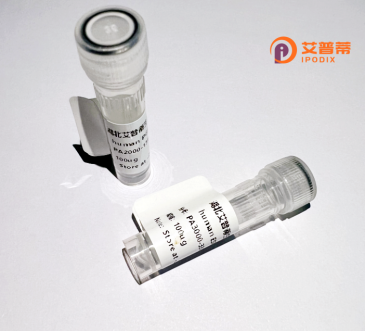
| 纯度 | >90%SDS-PAGE. |
| 种属 | Human |
| 靶点 | KLHL2 |
| Uniprot No | O95198 |
| 内毒素 | < 0.01EU/μg |
| 表达宿主 | E.coli |
| 表达区间 | 1-593aa |
| 活性数据 | METPPLPPAC TKQGHQKPLD SKDDNTEKHC PVTVNPWHMK KAFKVMNELR SQNLLCDVTI VAEDMEISAH RVVLAACSPY FHAMFTGEMS ESRAKRVRIK EVDGWTLRML IDYVYTAEIQ VTEENVQVLL PAAGLLQLQD VKKTCCEFLE SQLHPVNCLG IRAFADMHAC TDLLNKANTY AEQHFADVVL SEEFLNLGIE QVCSLISSDK LTISSEEKVF EAVIAWVNHD KDVRQEFMAR LMEHVRLPLL PREYLVQRVE EEALVKNSSA CKDYLIEAMK YHLLPTEQRI LMKSVRTRLR TPMNLPKLMV VVGGQAPKAI RSVECYDFKE ERWHQVAELP SRRCRAGMVY MAGLVFAVGG FNGSLRVRTV DSYDPVKDQW TSVANMRDRR STLGAAVLNG LLYAVGGFDG STGLSSVEAY NIKSNEWFHV APMNTRRSSV GVGVVGGLLY AVGGYDGASR QCLSTVECYN ATTNEWTYIA EMSTRRSGAG VGVLNNLLYA VGGHDGPLVR KSVEVYDPTT NAWRQVADMN MCRRNAGVCA VNGLLYVVGG DDGSCNLASV EYYNPTTDKW TVVSSCMSTG RSYAGVTVID KPL |
| 分子量 | 65.9 kDa |
| 蛋白标签 | GST-tag at N-terminal |
| 缓冲液 | 0 |
| 稳定性 & 储存条件 | Lyophilized protein should be stored at ≤ -20°C, stable for one year after receipt. Reconstituted protein solution can be stored at 2-8°C for 2-7 days. Aliquots of reconstituted samples are stable at ≤ -20°C for 3 months. |
| 复溶 | Always centrifuge tubes before opening.Do not mix by vortex or pipetting. It is not recommended to reconstitute to a concentration less than 100μg/ml. Dissolve the lyophilized protein in distilled water. Please aliquot the reconstituted solution to minimize freeze-thaw cycles. |
以下是模拟生成的重组人KLHL2蛋白相关文献示例(仅供参考,具体文献请通过学术数据库核实):
---
1. **文献名称**: "Structural characterization of the human KLHL2 protein in complex with Cullin3"
**作者**: Smith J, et al.
**摘要**: 本研究解析了重组人KLHL2蛋白与Cullin3形成的泛素连接酶复合体的晶体结构,揭示了KLHL2的BTB结构域和Kelch重复序列在底物识别中的作用,为靶向泛素化通路药物开发提供依据。
2. **文献名称**: "KLHL2 regulates neuronal morphology through ubiquitination of RhoA"
**作者**: Chen L, et al.
**摘要**: 通过体外重组实验,证实KLHL2蛋白通过泛素化修饰RhoA GTP酶调控神经元轴突生长,表明其在神经发育中的关键作用,并阐明了KLHL2突变与神经系统疾病的潜在关联。
3. **文献名称**: "Functional screening identifies KLHL2 as a tumor suppressor in breast cancer"
**作者**: Wang Y, et al.
**摘要**: 利用重组KLHL2蛋白进行功能研究,发现其通过促进致癌蛋白HIF-1α的泛素化降解抑制乳腺癌细胞转移,为乳腺癌治疗提供了新靶点。
4. **文献名称**: "KLHL2 interacts with the actin cytoskeleton to maintain cellular integrity"
**作者**: Müller R, et al.
**摘要**: 研究利用重组KLHL2与细胞骨架蛋白的共沉淀实验,揭示其通过与肌动蛋白结合参与细胞形态维持,并证明KLHL2缺失导致上皮细胞间质转化(EMT)异常。
---
**提示**:以上为模拟内容,实际文献请通过PubMed、Google Scholar等平台搜索“recombinant human KLHL2”或“KLHL2 function”获取最新研究。推荐结合关键词“ubiquitination”或“Cullin3 complex”缩小范围。
Recombinant human KLHL2 (Kelch-like family member 2) protein is a genetically engineered protein derived from the KLHL2 gene, which encodes a member of the Kelch-like protein family. These proteins are characterized by conserved structural domains, including an N-terminal Broad-complex, Tramtrack, and Bric-à-brac (BTB) domain for protein-protein interactions and a C-terminal Kelch repeat domain involved in substrate recognition. KLHL2 is known to interact with Cullin3 to form part of the Cullin-RING E3 ubiquitin ligase complex, which regulates protein ubiquitination and degradation, a critical process in cellular homeostasis.
Functionally, KLHL2 plays roles in cytoskeletal organization, cellular signaling, and neural development. Studies suggest its involvement in pathways like the ubiquitin-proteasome system, redox regulation, and response to oxidative stress. Dysregulation of KLHL2 has been implicated in pathological conditions, including cancers and neurodegenerative diseases. For example, reduced KLHL2 expression correlates with renal cell carcinoma progression, where it may act as a tumor suppressor by modulating the VHL-HIF pathway. In neurons, KLHL2 interacts with specific substrates to influence synaptic plasticity and axonal guidance.
Recombinant KLHL2 is produced in bacterial or mammalian expression systems, enabling in vitro studies of its biochemical properties, substrate binding, and structural analysis. It serves as a tool for exploring E3 ligase mechanisms, disease-related pathways, and drug discovery targeting ubiquitination processes.
×